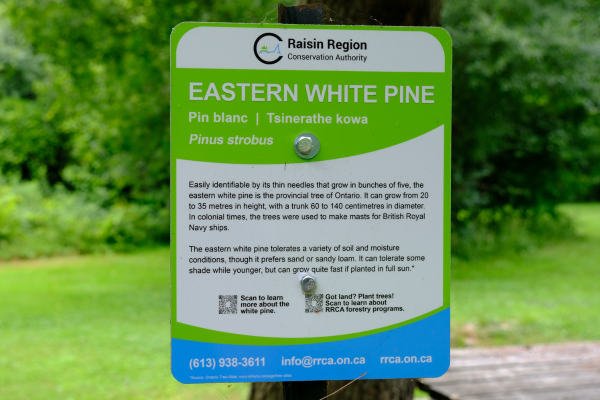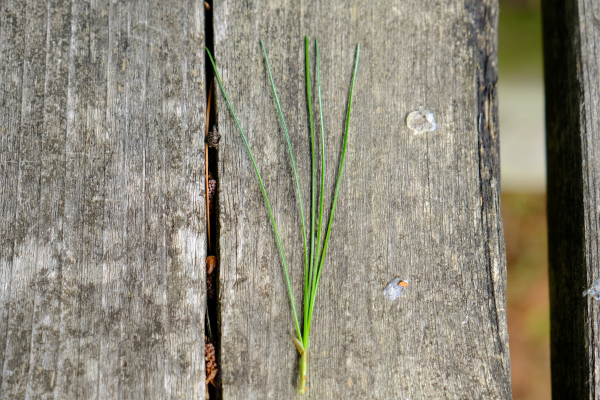Scientific name: Pinus strobus
Pinus = Comes from the Latin name for pines.
strobus = relates to the Greek word strobilos, meaning “whirlwind” which may relate to the arrangement of the seeds within the cone in continuous circles.
Ontario’s provincial tree, white pine, can be seen growing throughout all of Ontario. The dense branches of this tree make them ideal nesting and roosting spots for many bird species, especially owls like the great horned owl. Its seeds are eaten by birds and small mammals. White pine can be differentiated from other pines using their needles. Its long, skinny needles come in clusters of 5. This is the same number as the number of letters in the word W-H-I-T-E, which makes it easy to remember.
White pine can tolerate varying levels of moisture and can be grown in any soil type, though it thrives in sand or a sandy loam. While young, white pine can tolerate partial shade, but this tree much prefers full sun, where it will grow much quicker allowing it to be used to create shade, such as for your house. When grown in an area that is exposed to a lot of wind, white pine can become somewhat lopsided, with the exposed side often having shorter branches.
In colonial times, the tallest white pines were used to make ship masts for the British Royal Navy. The inner bark was also used for food and as an ingredient in cough remedies. The Iroquois would mix the resin from the tree with beeswax to create a waterproof sealant for their canoes. Currently, white pine is one of the most widely used lumber sources in North America, with its soft, light wood being used to create cabinets, interior finishes, and hand carved objects. White pines are also used as Christmas trees! They have good needle retention though their weaker branches are not a good fit for heavier ornaments. The pine needles can also be used in teas, to see how to make tea from pine needles, check out "How To Make The Perfect White Pine Tea."
Sources:
OMNR, 2022. Ontario Ministry of Natural Resources: Ontario Tree Atlas. [online] Available: https://www.ontario.ca/page/eastern-white-pine
Ontario Wildlife Federation. 2022. Plant & Habitat Fact Sheets - Eastern White Pine. [online] Available: https://www.ontwf.org/wp-content/uploads/2015/12/fact-sheet-EasternWhitePine.pdf
McKinley, C. 2022. White Pine. National Christmas Tree Society. [online] Available: https://realchristmastrees.org/education/tree-varieties/white-pine/
University of Guelph. The Arboretum: Eastern White Pine - Pinus strobus. [online] Available: https://arboretum.uoguelph.ca/thingstosee/trees/easternwhitepine
%20938-3611%20info%40rrca_on_ca%20rrca_on_catrees%20(400%20%C3%97%20200%20px)%20(1).jpg)


 Eastern white pine forests used to cover much of north-central and north-eastern North America. Now only 1 percent of those old-growth forests remain after extensive logging conducted from the 18th to 20th century.
Eastern white pine forests used to cover much of north-central and north-eastern North America. Now only 1 percent of those old-growth forests remain after extensive logging conducted from the 18th to 20th century..png) White pine is a long-lived species, able to reach 200 years or more in age and can grow up to 45 meters in height.
White pine is a long-lived species, able to reach 200 years or more in age and can grow up to 45 meters in height. .png) The bark of mature trees is dark gray to brown with fissures, showing deep ridges and indents.
The bark of mature trees is dark gray to brown with fissures, showing deep ridges and indents.  The skinny needles of white pine can be 6 to 12 centimeters long and grow in bunches of five.
The skinny needles of white pine can be 6 to 12 centimeters long and grow in bunches of five. .png) Cones are 8-20 centimeters long and hang down from the tree’s branches. They begin green in colour which then ripen to brown when the seeds are ready to be released.
Cones are 8-20 centimeters long and hang down from the tree’s branches. They begin green in colour which then ripen to brown when the seeds are ready to be released.